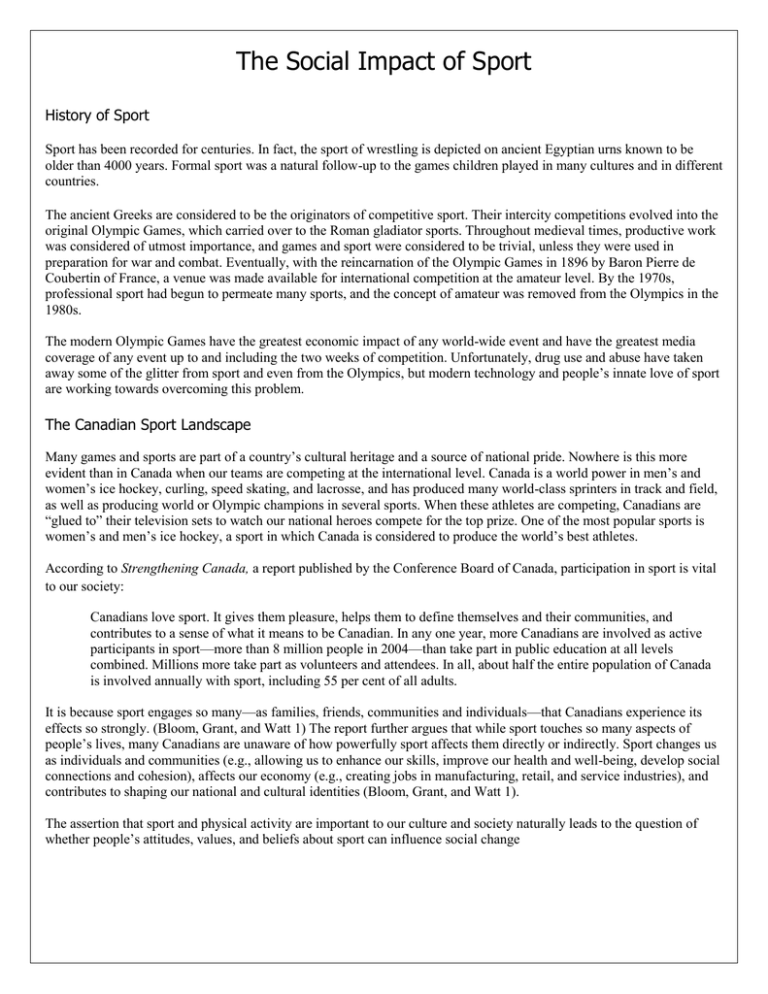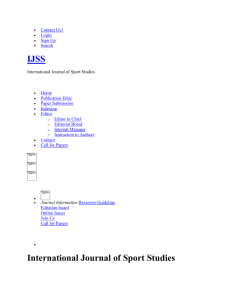The Social Impact of Sport History of Sport Sport has been recorded
advertisement

The Social Impact of Sport History of Sport Sport has been recorded for centuries. In fact, the sport of wrestling is depicted on ancient Egyptian urns known to be older than 4000 years. Formal sport was a natural follow-up to the games children played in many cultures and in different countries. The ancient Greeks are considered to be the originators of competitive sport. Their intercity competitions evolved into the original Olympic Games, which carried over to the Roman gladiator sports. Throughout medieval times, productive work was considered of utmost importance, and games and sport were considered to be trivial, unless they were used in preparation for war and combat. Eventually, with the reincarnation of the Olympic Games in 1896 by Baron Pierre de Coubertin of France, a venue was made available for international competition at the amateur level. By the 1970s, professional sport had begun to permeate many sports, and the concept of amateur was removed from the Olympics in the 1980s. The modern Olympic Games have the greatest economic impact of any world-wide event and have the greatest media coverage of any event up to and including the two weeks of competition. Unfortunately, drug use and abuse have taken away some of the glitter from sport and even from the Olympics, but modern technology and people’s innate love of sport are working towards overcoming this problem. The Canadian Sport Landscape Many games and sports are part of a country’s cultural heritage and a source of national pride. Nowhere is this more evident than in Canada when our teams are competing at the international level. Canada is a world power in men’s and women’s ice hockey, curling, speed skating, and lacrosse, and has produced many world-class sprinters in track and field, as well as producing world or Olympic champions in several sports. When these athletes are competing, Canadians are “glued to” their television sets to watch our national heroes compete for the top prize. One of the most popular sports is women’s and men’s ice hockey, a sport in which Canada is considered to produce the world’s best athletes. According to Strengthening Canada, a report published by the Conference Board of Canada, participation in sport is vital to our society: Canadians love sport. It gives them pleasure, helps them to define themselves and their communities, and contributes to a sense of what it means to be Canadian. In any one year, more Canadians are involved as active participants in sport—more than 8 million people in 2004—than take part in public education at all levels combined. Millions more take part as volunteers and attendees. In all, about half the entire population of Canada is involved annually with sport, including 55 per cent of all adults. It is because sport engages so many—as families, friends, communities and individuals—that Canadians experience its effects so strongly. (Bloom, Grant, and Watt 1) The report further argues that while sport touches so many aspects of people’s lives, many Canadians are unaware of how powerfully sport affects them directly or indirectly. Sport changes us as individuals and communities (e.g., allowing us to enhance our skills, improve our health and well-being, develop social connections and cohesion), affects our economy (e.g., creating jobs in manufacturing, retail, and service industries), and contributes to shaping our national and cultural identities (Bloom, Grant, and Watt 1). The assertion that sport and physical activity are important to our culture and society naturally leads to the question of whether people’s attitudes, values, and beliefs about sport can influence social change The Media and Sport Partnerships The world seems to shrink every day due to the high level of connectedness achieved by the many forms of media. Essentially, there are two forms of media: Print media include newspapers, magazines, and books Electronic media include television, radio, and the Internet. Sport, sport media, large corporations, and business in general are all linked, making this unique partnership a significant economic contributor to society. But sport media also fulfill many other functions, such as the following: The media educate consumers about a game or sport, its history, the players, and the strategies involved in the contest, making all of us “armchair experts” on the game so that we can discuss and debate the events with others. The media create excitement about upcoming events, motivating people to become avid consumers, not only of the contest itself but also of all the festivities surrounding it. Many people will watch a significant game (e.g., Stanley Cup final) even if they do not usually watch the sport. The media create emotional attachments to athletes, coaches, and teams through the many features leading up to the start of a new season of play. The media often focus attention on athletes who have been injured, or who have had to overcome adversity in their lives to get them to a certain point. The media provide a form of recreation and entertainment for many people, which is of great value in stressful lives. Cheering for a local or favourite team or player is the type of excitement and drama that can make a difference in a person’s life. The media relate stories on social concerns that attract attention, stimulate thinking, and often create lively debate. Significant topics addressed in the media include issues related to… o racial discrimination and inequities (e.g., coaching assignments, player positions, team names, logos, mascots) o sport economics (e.g., profits, salaries, endorsements, public financing, careers) o gender inequities (e.g., salaries, attire, opportunity) o sport ethics (e.g., cheating, fighting, gambling, athlete and fan behaviour, alcohol and tobacco sponsorships, role modelling, sexual harassment) o technological advancements (e.g., playing surfaces, equipment, clothing) o substance use and abuse (e.g., steroids, alcohol, drug testing, blood doping, penalties) Social Issues and Values The following are examples of social issues that affect sport participation and development, including access to sport participation for populations with specific or exceptional needs: Special Olympics In the early 1960s the Kennedy Foundation in Washington, DC, began to promote international games for individuals who were intellectually challenged. The Kennedy Foundation hired Dr. Frank Hayden, a well-known Canadian researcher in the area of fitness and people with disabilities, and thus the Special Olympic Games were initiated in 1968, primarily with athletes from the United States and Canada. Events were later added for athletes who were physically challenged. Hayden and other more recent investigators have shown that the low fitness levels demonstrated by athletes with intellectual disabilities in the 1960s and 1970s were the result of physical inactivity. Testing has shown that these athletes are among the fitness elite, not only in physical skills for their peer groups, but also, in many cases, when compared with other athletes. Today the Special Olympic Games are the second largest international events, next to the Olympic Games. Paralympic Games Athletes with disabilities were included in the Olympic Games for the first time in Rome in 1960. By the 1976 Olympic Games in Toronto, more groups with disabilities were added. That same year the Winter Paralympics took place in Sweden. Since that time, groups with disabilities have increasingly been included in international sports competitions. Today, six different groups with disabilities are involved in the Paralympics, with athletic achievement being highlighted over disability. The number of athletes participating in the Summer Paralympics, for example, has increased from 400 athletes from 23 countries in Rome in 1960 to 3806 athletes from 136 countries in Athens in 2004 (International Paralympics Committee). Currently, the Paralympics and the Olympic Games are both held in the same year and in the same location. Aboriginal Sport Participation In Canada the Aboriginal Sport Circle is the national voice for Aboriginal sport, bringing together the interests of First Nations, Inuit, and Métis peoples. Established in 1995, the Aboriginal Sport Circle was created in response to the need for more accessible and equitable sport and recreation opportunities for Aboriginal peoples. Canada is viewed throughout the world as a leader in promoting and protecting the rights of all its citizens, including the access and participation in sport and physical activity programs. Today, many Native bands and individuals located near cities participate in athletic leagues. As well, every four years competitive games are held between Aboriginals from places such as Nunavut, the Northwest Territories, Yukon Territory, and Alaska. The competitions include indigenous games and demonstrations such as the arm pull and high kicking. Gender Equity in Sport One of the most consistent injustices of the past and present is the lack of equal access to, for example, job opportunities for women in our society. The quest for equitable and fair access in all aspects of society including sport is still a struggle today, although great strides have been made in recent history. According to the Canadian Association for the Advancement of Women and Sport and Physical Activity, “no women took part in the first modern Olympic Games in 1896” (CAAWS, “Introduction”). At the 26th Olympic Games (1996) in Atlanta, for example, 97 of the 271 events were open to women, with both women and men contesting in 11 events; 3626 of the 10 629 athletes were women. Canada has fared better than other major countries when it comes to representation: “Of the 307 Canadian athletes who competed in Atlanta, 154 were women and 153 were men, making it the first Canadian Olympic team ever to consist of more women than men, an impressive shift in a short time” (CAAWS, “Introduction”). Physical Activity and Sport for Older Adults As humans age, the body begins to deteriorate, from the cellular level to the total body. Aging is inevitable, and the process cannot be stopped. Research has shown, however, that it is possible to slow the loss of physiological and physical functions through exercise and sport. The Canadian Centre for Activity and Aging is a world leader in aging research and provides practical advice and materials on the benefits of physical activity for older adults. Recently, the Canadian government was instrumental in the formation of the Canada Senior Games, a national competition for seniors over the age of 55, which includes sports such as snooker, swimming, five-pin bowling, golf, and track. Technology and Sport New sport products are continually being developed, including sportswear, court and field surfaces, equipment, fabrics, and materials. The primary reasons for the development of new products are safety, increased speed of movement (e.g., better trained athletes and the design of playing tools such as the shape and size of balls and the configuration of skis), and improved performance. Innovations in sport products (e.g., larger racquet heads, new waxing techniques for cross-country skiers) have made sport easier for beginners, assisted top-level athletes to reach superior performances, and eased the transition from individual to team play and from recreational sport to highly competitive sport. Sport as Business Sport is big business. More individuals participate in sport as spectators, athletes, and/or administrators than are involved in any other singular human endeavour. In many nations, including Canada, more money is spent on physical activity and sportswear, admission fees, salaries, equipment, and facilities than on the armed services or on any other area of concern, with the exception of health care. Sport involvement contributes to the fitness level of the nation, serves as a major form of entertainment, contributes to personal and national pride, provides employment for thousands of individuals, results in the construction of superior facilities, and thus contributes significantly to the gross national product of the country. Sporting Behaviour All societies in the world are governed by a set of rules that have been decided upon by the society as a whole, their elected representatives, or the rulers of that society. These rules, known as the laws of the land, are necessary so that anarchy does not take hold. In many instances, sport serves as a microcosm of society. It is necessary to have guidelines, rules, or regulations of the way a sport is to be played. These rules are pliable but become less flexible as sport moves from recreational physical activity to formal structures, such as sports leagues. It is essential that all teams involved at similar levels play by the same set of regulations. Even at the elite or professional level, however, opportunities must be available to change the rules of sport, whether by popular demand, for safety reasons, or for spectator and participant appeal. The rules of sport, like the rules of society, are meant to satisfy the needs of the participants and spectators, and must be seen to be fair, equitable, and judicious; that is, they must include a set of consequences/penalties for a hierarchy of transgressions or deviant behaviour. Sporting behaviour is the term used to reflect sportsmanship, as it pertains to ethical behaviour, fair play, and respect for the sport, the participants, and the spectators. Elite athletes have become societal role models, whether or not they wish to carry this burden. In recent years, because of increased and instantaneous media attention, the behaviour of these athletes has come under society’s microscope, off as well as on the playing field, for every aspect of their lives. As a result, elite athletes seriously influence the moral and ethical development of children and youth of many societies. Sport can also build character and personal qualities, such as courage, integrity, and the capacity to commit to a goal or purpose, as well as values such as a sense of responsibility to others, respect for others, self-discipline, a sense of fair play and fair dealing, and honesty. Character Versus Sport Ethic More often than not, the assumption is made that having good character also represents the dominant sport ethic. In other words, the athletes’ behaviours are consistent with the behaviour norms that are applauded and praised by the sporting culture. Individual character and the prevailing sport ethic may, however, counter each other. Athletes who demonstrate and endorse the sport ethic are rewarded, while those who rebel find it difficult to be a part of the accepted society. When athletes are exposed to various ethical dilemmas in sport over a period of time, they may eventually adopt unethical behaviours that are expected of them (e.g., hockey players may be expected to fight or to take penalties for their team). The behaviours are often reinforced and appreciated by the fans and media. Although the behaviours are accepted within the insular world of sport, they are often not acceptable in the world outside of sport. The newspapers and television are full of examples of athletes who have difficulty keeping the line clearly drawn between the world of sport and the world outside of sport. Deviant Behaviour in Sport The term deviant behaviour describes actions or behaviours that take place in sport that are outside expected or acceptable limits. This definition helps distinguish between behaviours that are governed within the rules of the sport and those that may be questioned, reviewed, or acted upon by the parent sport organization (e.g., National Hockey League) or by the judicial system. Deviant behaviour in sport may include the following: Rule breaking: When rules are broken unintentionally during competition, or when rules are broken intentionally but the results are not severe, game officials make a ruling. Organizational or judicial intervention may become necessary when the rules are broken intentionally or result in great harm. The penalties or sanctions levied against the perpetrators range from heavy fines to lifetime bans in the sport, and, in some cases, result in criminal charges. Emotional involvement: Different levels of emotional involvement could also be considered deviant behaviour. In many countries, sporting events have evolved into avenues for emotional release and relief. Generally, the more important the event is, the greater the emotional expression becomes, whether it be joy, anger, wonderment, or sadness. Often the emotions are irrational and, in many instances, lead to violence, usually between opposing team spectators, but sometimes between opponents, athletes, and spectators, or even game officials. In any case, these actions are immature and antisocial, and are definitely not acceptable. The Social Impact of Sport Questions 1. Who are the “originators” of competitive sport? 2. List five different ways media is involved in sport and in the portrayal of social issues? 3. When were the Special Olympics initiated and who was the famous Canadian researcher that helped develop the event? 4. How have the Paralympic Games evolved since the Olympic Games in Rome in 1960? Support your answer with a quote from the article. 5. How has the participation of females in the Olympic Games changed since the first modern Olympic Games in 1896? Support your answer with a quote from the article. 6. At what age are people allowed to participate in the Canada Senior Games? 7. List three ways that the development of new sport products has impacted athletes. 8. “In many nations, including Canada, more money is spent on physical activity and sportswear, admission fees, salaries, equipment, and facilities than on the armed services or on any other area of concern…” What is the only exception to this statement? 9. Why is sport considered to have an important role in society? Explain. 10. What is the difference between sporting behaviour and deviant behaviour in sport? 11. How does sport build or reveal the positive or negative character of an individual? Who or what influences athletes behavior in sport? 12. List three athletes who are positive role models for young sport competitors. Explain why. 13. List three athletes who are negative role models for young sport competitors. Explain why. 14. How does sport build or reveal the positive or negative character of an individual? How is character “learned”?




